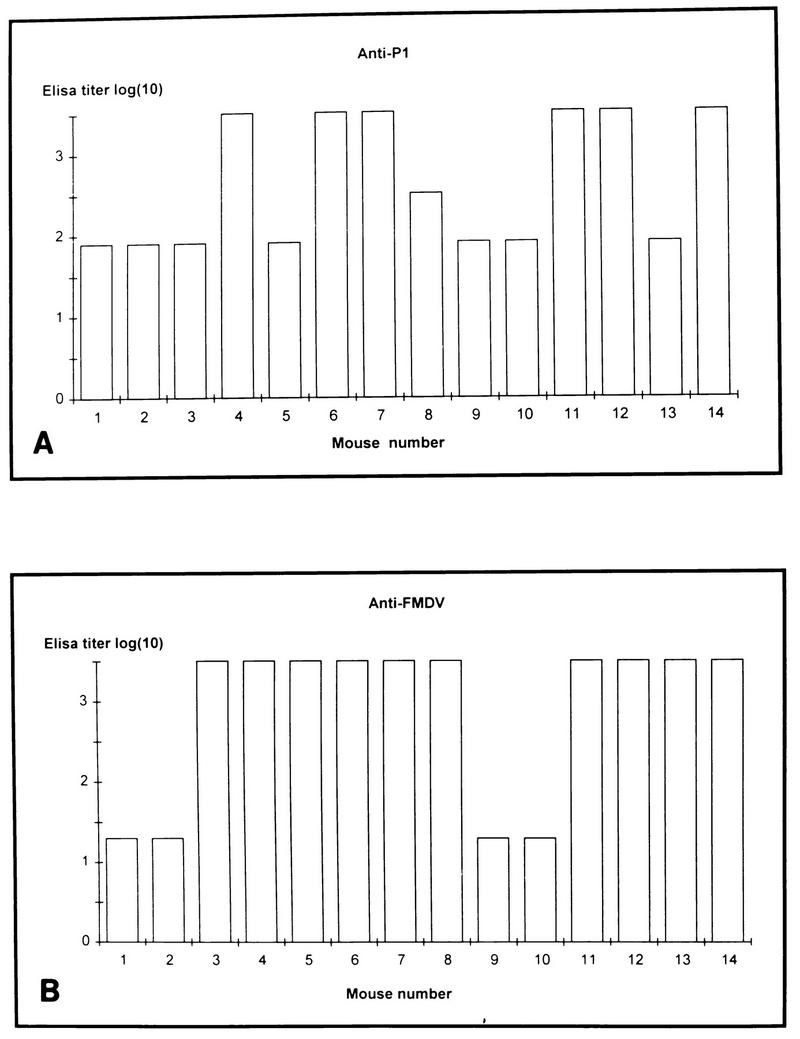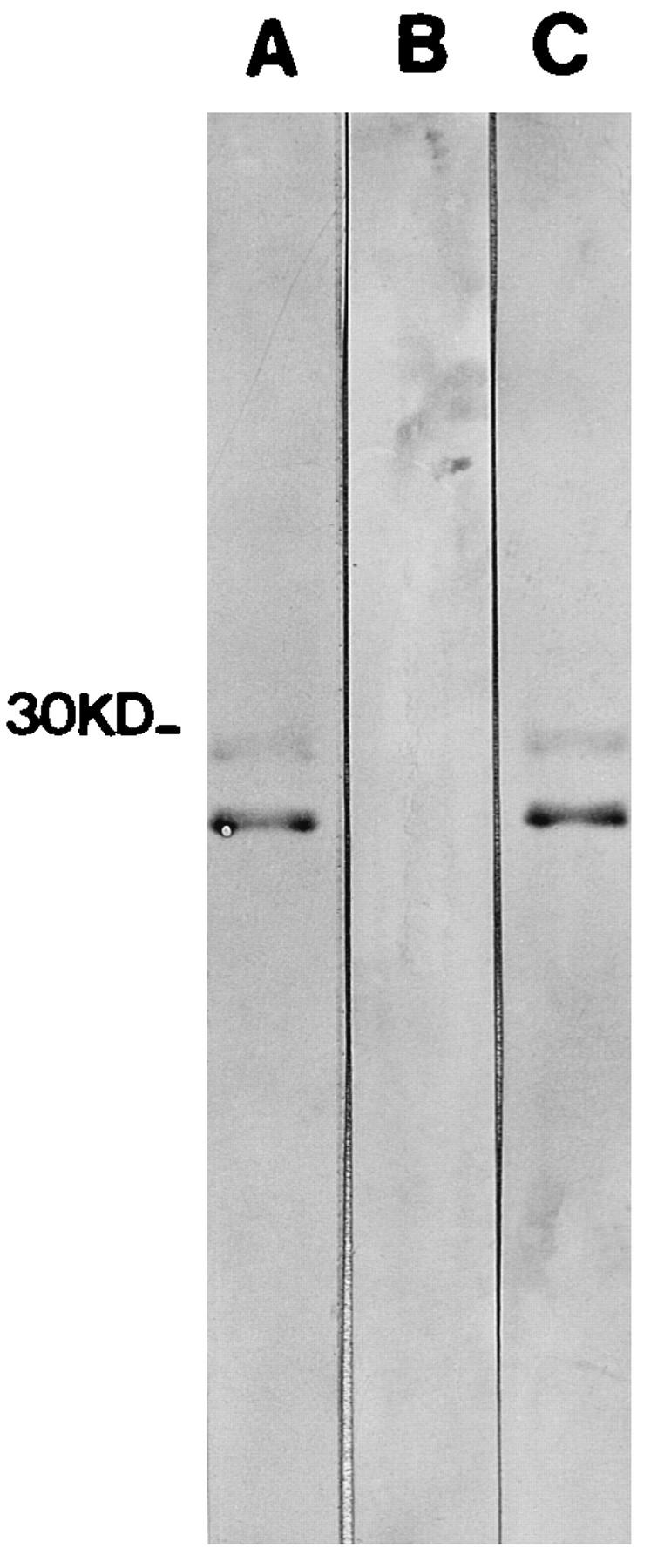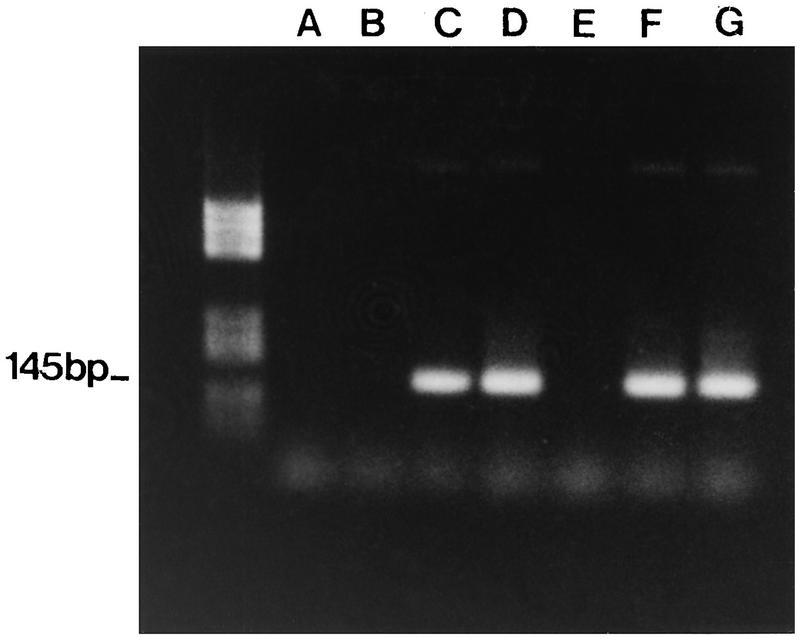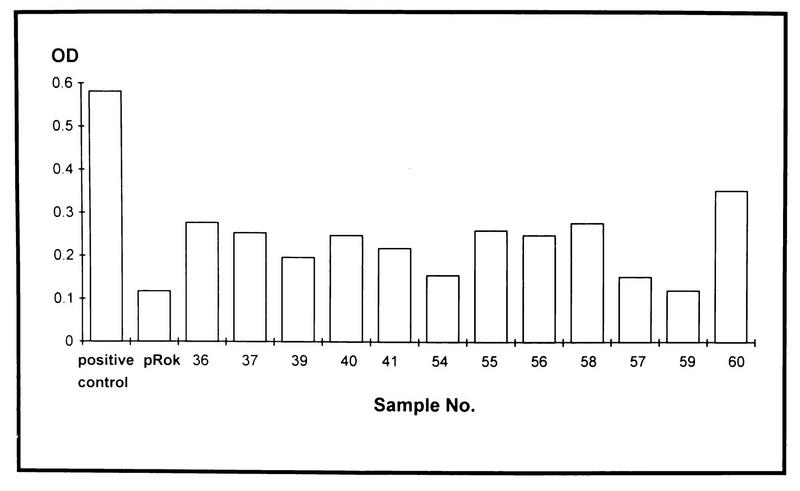Abstract
It has been reported recently that genes encoding antigens of bacterial and viral pathogens can be expressed in plants in a form in which they retain native immunogenic properties. The structural protein VP1 of foot-and-mouth disease virus (FMDV), which has frequently been shown to contain critical epitopes, has been expressed in different vectors and shown to induce virus-neutralizing antibodies and protection in experimental and natural hosts. Here we report the production of transformed plants (Arabidopsis thaliana) expressing VP1. Mice immunized with leaf plant extracts elicited specific antibody responses to synthetic peptides representing amino acid residues 135 to 160 of VP1, to VP1 itself, and to intact FMDV particles. Additionally, all of the immunized mice were protected against challenge with virulent FMDV. To our knowledge, this is the first study showing protection against a viral disease by immunization with an antigen expressed in a transgenic plant.
Recently, the utilization of plants as expression vectors for the production of foreign proteins has been reported. Viral proteins (15–17, 21), bacterial toxins (9), and antibody molecules (8, 11, 12, 14) have been expressed successfully in transgenic plants. In most cases, the expressed proteins were fully functional as antigens (9, 15–17, 21) or in ligand recognition (8, 11, 12, 14). Importantly, they were effective as immunogens in eliciting specific immune responses (9, 16, 21). The production of immunogens in plants might be an economical alternative to fermentation-based production systems for the development of vaccines.
Foot-and-mouth disease virus (FMDV) is the causative agent of a disease of great economic significance affecting meat- and milk-producing domestic animals (4). Comprehensive vaccination of all susceptible hosts with inactivated virus as the immunogen has been very successful and constitutes the basis of all sanitary plans for controlling and eradicating the disease (5). Current vaccines are based on the utilization of inactivated virus, and although they have proved to be effective tools for the prevention of the disease, their production includes considerable risk in the dissemination of the virus from vaccine factories (4). Thus, it is important to develop alternative approaches for producing experimental vaccines. Many studies have shown that the structural protein VP1 carries critical epitopes responsible for the induction of neutralizing antibodies (reviewed in reference 4). Immunization with VP1, or with synthetic peptides representing part of its amino acid sequence, has been demonstrated to induce protection against challenge in experimental and natural hosts (reviewed in reference 4). Production of complete or fractionated VP1 in a diversity of expression systems has been performed frequently in the search for an effective and inexpensive alternative which would be highly immunogenic (7, 13, 18, 22). Here, we describe the production of transgenic Arabidopsis thaliana plants expressing FMDV VP1 and its utilization as an immunogen in experimental hosts.
The construction of the transformation vector was based on the binary plasmid pRok1 (1). The VP1 gene was amplified by reverse transcription-PCR from viral RNA obtained from BHK-21 cells infected with O1 Campos (O1C) FMDV. The pair of oligonucleotides utilized (forward primer, 5′ AGCGGATCCTGTCATGGCCACTGTTGAA 3′; reverse primer, 5′ AAGGGGATCCTCTAGAGTCTACTTGAG 3′) introduced start and stop codons 5′ and 3′ of the gene, respectively, and BamHI sites at both ends of the amplified product. The complete VP1 gene was then cloned in the BamHI site of pRok (pRok.VP1).
Plant transformation was performed as described elsewhere (2) with slight modifications. Briefly, seeds of A. thaliana (L) (Heynh; ecotype Columbia) were sown in pots which were placed at 4°C for 48 h in darkness (to synchronize germination) and later transferred to a growth chamber at 20°C with a 16-h photoperiod. Irrigation was carried out with distilled water and occasionally with mineral nutrient solution (10). Agrobacterium tumefaciens (strain C58C1) cells, containing either pRok.VP1 or pRok, were grown in Luria-Bertani medium containing 50 mg of kanamycin per ml. After centrifugation, bacteria were resuspended in 200 ml of 2.35 g of Murashige and Skoog medium (19) per liter containing 10 g of 6-benzilaminopurine per liter and 5% sucrose. Six- to 7-week-old plants were immersed in the Agrobacterium suspension by inverting the pots, and vacuum infiltration was performed in a vacuum chamber at 5 × 106 mPa for 15 min. Infiltrated plants were rinsed with water and placed in a greenhouse until attaining maturity. Transgenic T1 seeds were selected by germination in Petri dishes containing GM (4.7 g of Murashige and Skoog per liter 1% sucrose, 0.5 g of MES [morpholineethanesulfonic acid] per liter, 8 g of agar per liter [pH 5.7]) and 50 mg of kanamycin per ml. Two-week-old transgenic plants were transplanted to soil and allowed to attain maturity in order to be used for further analysis.
The presence of the VP1 gene in the transgenic plants was detected by PCR. Plant extracts (approximately 50 mg) were prepared by macerating frozen leaves in liquid nitrogen with pestle and mortar. The resulting powder extract was successively resuspended in 50 μl of 250 mM NaOH, boiled for 1 min, ice cooled, mixed with 50 μl of 250 mM CIH, buffered with 25 μl of 1 M Tris (pH 8.3), boiled for 2 min, and ice cooled. PCR was performed on 5 μl of the extract with a pair of primers which specifically amplify a 145-bp fragment of the VP1 gene between positions 369 and 490 (forward primer, 5′ CCGGATCCTGGCAACC ATGTACA 3′; reverse primer, 5′ GTCGCATATGTGGCACCGTAGTT 3′). PCR analysis showed the presence of a product of the expected size in all plants transformed with pRok.VP1. On the other hand, this product was consistently absent in those plants transformed with pRok (Fig. 1).
FIG. 1.
Detection of the VP1 gene in transgenic plants by PCR. Plant DNA was isolated from cell extracts, and PCR was performed with a pair of primers designed to amplify the region between positions 369 and 490 of the VP1 gene. Lanes: A, nontemplate; B and E, DNA from pRok-transformed plants; C, D, and F, DNA from pRok.VP1-transformed plants; G, pRok.VP1 plasmid.
The presence of recombinant protein in the plants harboring the VP1 gene was tested by enzyme-linked immunosorbent assay (ELISA). Approximately 10% of the selected plants were clearly positive (Fig. 2). Additionally, pRok.VP1 plant extracts analyzed by Western blot with an anti-VP1 antiserum presented a weak, although specific, band with the expected relative mobility (data not shown). Different recombinant plant lines harboring the VP1 gene and expressing the transgenic protein were selected and pooled to obtain material for the immunization experiments.
FIG. 2.
Detection of VP1 in transgenic plants by ELISA. Ninety-six-well Immulon 2 ELISA plates (Dynatech) were coated with a rabbit anti-p135-160 antiserum in carbonate buffer (pH 9.6) for 12 h at 4°C. The plates were then washed three times with PBST and blocked with 3% horse serum in PBST for 1 h at 37°C (all subsequent steps were performed with this buffer). Then, a fourfold dilution of extracts from the plants to be tested were added and incubated for 1 h at 37°C. The plates were washed, and a pool of mouse anti-p135-160 antisera was added. The plates were then washed three times and incubated for 1 h at 37°C with peroxidase-labeled rabbit anti-mouse immunoglobulin antibodies (Dakkopats). After three washes, the reaction was developed by the addition of O-phenylenediamine–H2O2 in citrate buffer (pH 5) and read 10 min later at 490 nm in an MR 500 Microplate Reader (Dynatech). Results are presented as rough optical density (OD) readings. Positive control is an extract of a plant transformed with pRok with the addition of p135-160 (10μg/ml).
Plant extracts were prepared by macerating approximately 50 to 100 mg of frozen leaves in 1 ml of phosphate-buffered saline–0.025% Tween 20 (PBST). Preparations were clarified by centrifugation, and the supernatants were used for inoculation. Adult (60- to 90-day-old) male BALB/c mice were immunized intraperitoneally (i.p.) at days 0, 21, and 35 with 0.5 ml of plant extracts emulsified in incomplete Freund’s adjuvant. Ten days after the last booster, the animals were bled and sera were analyzed for the presence of anti-FMDV antibodies. Antibodies raised in immunized mice showed a strong reaction in the ELISA to a synthetic peptide (p135-160) which represents the amino acid residues of FMDV VP1 O1C from position 135 to 160 (22) (Fig. 3A). The specificity of this anti-VP1 response was confirmed by Western blotting, using purified FMDV as an antigen, in which a pool of sera from mice immunized with plants expressing the recombinant protein specifically recognized a protein with the same relative mobility as the one recognized by an immune serum raised against p135-160 (Fig. 4). Finally, the specific immune response against intact FMDV particles was analyzed by ELISA. All animals immunized with plants expressing VP1 developed a strong immune response, which in each individual had a magnitude similar to that detected by ELISA against p135-160 (Fig. 3B). Sera from mice immunized with leaf extract from plants transformed with plasmid pRok did not present reactivity in either the ELISA or Western blot analysis, supporting the specificity of the immune response induced by the extracts from plants containing VP1 (Fig. 3A and B and Fig. 4).
FIG. 3.

ELISA detection of antibodies to p135-160 (A) and anti-FMDV particles (B) in mice immunized with transformed plants. Briefly, the assay was performed exactly as described previously for detection of VP1 in transgenic plants regarding the capture of antigen to the plate and the blocking, washing, developing, and reading steps (20). Antigen was added after the capture antibody (p135-160 at a concentration of 10 μg/ml and purified inactivated FMDV at a concentration of 1 μg/ml) and incubated for 1 h at 37°C. Sera were tested in a fourfold dilution series in blocking buffer. Serum titers are expressed as the log of the reciprocal of the highest serum dilution which presents optical density (OD) readings above the mean OD readings plus 5 standard deviations of sera from five animals immunized with plants transformed with pRok.
FIG. 4.

Anti-VP1 antibodies detected by Western blotting. FMDV (produced, inactivated, and purified as described by Berinstein et al. [3]) was resuspended in sample buffer (50 mM Tris [pH 7.5], 1 mM phenylmethylsulfonyl fluoride, 4 M urea, 1% sodium dodecyl sulfate [SDS], 2 mM dithiothreitol, and 2% 2-β-mercaptoethanol), boiled 3 min, subjected to SDS–12.5% polyacrylamide gel electrophoresis, and blotted to an Immobilon P (Millipore) membrane. The membrane was blocked overnight with PBST containing 3% skim milk (all subsequent steps were performed with this buffer) and incubated with the corresponding mouse sera (diluted 1/50) for 2 h at 37°C. The membrane was washed and incubated with an alkaline phosphatase-labeled anti-mouse immunoglobulin rabbit antiserum (Dakkopats) for 1 h at 37°C and then washed three more times, and the reaction was developed by the addition of the substrate nitroblue tetrazolium–4-chloro-3-indolylphosphate. Sera from mice immunized with plant extracts were used for the reaction. Lanes A through C correspond to anti-p135-160 antiserum, a pool of sera from mice immunized with pRok-transformed plants, and a pool of sera from mice immunized with pRok.VP1-transformed plants, respectively.
The protective effect induced by the plant-derived VP1 was tested by challenging the immunized mice with virulent virus. Importantly, all 14 of the mice immunized with plants expressing VP1 (pRok.VP1 plant extracts) were protected against i.p. challenge with 104 suckling-mouse 50% lethal doses of FMDV O1C, while all 6 animals immunized with cell extracts from transgenic plants transformed with pRok, as well as the 6 unimmunized controls, became infected. (Protection was defined as the absence of viremia in the challenged mice at 48 h postinoculation. Viremia was tested by intramuscular inoculation of a 5- to 6-day-old litter [six mice per blood sample] with a 1/10 dilution of peripheral blood [50 μl per mouse].)
The concept of vaccine production in transgenic plants was first described by Mason et al. in 1992 (15), and several authors have described antibody responses to parenterally or orally administered plant-derived antigens (9, 16, 21). In the present work we describe an alternative method for expressing VP1 by using transgenic plants as a vector. The plant-derived VP1 was able to induce, in parenterally immunized mice, a virus-specific antibody response and solid protection against virulent virus challenge. Although the induction of a protective immune reaction with a plant virus used as an expression vector in minks immunized with recombinant chimeric particles of the cowpea mosaic virus has been described (6), to our knowledge ours is the first study showing protection against a viral disease by immunization with an antigen expressed in transgenic plants. These findings support the concept of using transgenic plants as a novel and safe system of inexpensive vaccine production, which could became a very attractive alternative in the developing world.
Acknowledgments
This work was supported by grant BID 802/OC-AR PID 168 from SECYT-CONICET, Rep. Argentina, and by grant BIO96-1172 from Comisión Interministerial de Ciencia y Tecnología of Spain.
We acknowledge the technical assistance of Antonio Varone and Laboratory Bayer, División Sanidad Animal, Argentina, where the challenge experiments were conducted. We also thank C. L. Afonso for helpful discussions and suggestions.
REFERENCES
- 1.Baulcombe D C, Saunders G R, Bevan M W, Mayo M A, Harrison B D. Expression of biologically active viral satelite RNA from nuclear genome of transformed plants. Nature. 1986;321:446–449. [Google Scholar]
- 2.Bechtold N, Ellis J, Pelletier G. Agrobacterium mediated gene transfer by infiltration of adult Arabidpsis thaliana plants. CR Acad Sci Paris Sciences de la vie. 1993;316:1194–1199. [Google Scholar]
- 3.Berinstein A, Piatti P, Gaggino O P, Schudel A A, Sadir A M. Enhancement of the immune response elicited with foot-and-mouth disease virus vaccines by an extract of the Mycobacterium sp. wall. Vaccine. 1991;9:883–888. doi: 10.1016/0264-410x(91)90008-t. [DOI] [PubMed] [Google Scholar]
- 4.Brown F. Vaccination against foot and mouth disease virus. Vaccine. 1992;10:1022–1026. doi: 10.1016/0264-410x(92)90111-v. [DOI] [PubMed] [Google Scholar]
- 5.Cottral G. Committee on Foreing Animal Diseases (ed.), Foreing Animal Disease. 3rd ed. Richmond, Va: United States Animal Health Association; 1975. Foot and mouth disease virus. [Google Scholar]
- 6.Dalsgaard K, Uttenthal A, Jones T D, Xu F, Merryweather A, Hamilton W D, Langeveld J P, Boshuizen R S, Kamstrup S, Lomonossoff G P, Porta C, Vela C, Casal J I, Meloen R H, Rodgers P B. Plant derived vaccine protects target animals against a viral disease. Nat Biotechnol. 1997;15:248–252. doi: 10.1038/nbt0397-248. [DOI] [PubMed] [Google Scholar]
- 7.DiMarchi R, Brooke G, Gale C, Cracknell V, Doel T, Mowat N. Protection in cattle against foot and mouth disease by a synthetic peptide. Science. 1986;232:639–647. doi: 10.1126/science.3008333. [DOI] [PubMed] [Google Scholar]
- 8.During K, Hippe S, Kreuzaler F, Schell J. Synthesis and self-assembly of a functional monoclonal antibody in transgenic Nicotiana tabacum. Plant Mol Biol. 1990;15:281–293. doi: 10.1007/BF00036914. [DOI] [PubMed] [Google Scholar]
- 9.Haq T A, Mason H S, Clements J D, Arntzen C J. Oral immunization with recombinant bacterial antigen produced in transgenic plants. Science. 1995;268:714–716. doi: 10.1126/science.7732379. [DOI] [PubMed] [Google Scholar]
- 10.Haughn G, Somerville C. Sulfonylurea-resistant mutants of Arabidopsis thaliana. Mol Gen Genet. 1986;204:430–434. [Google Scholar]
- 11.Hein M B, Tang Y, McLeon D A, Janda K D, Hiatt A. Evaluation of immunoglobulins from plant cells. Biotechnol Prog. 1992;7:455–461. doi: 10.1021/bp00011a011. [DOI] [PubMed] [Google Scholar]
- 12.Hiatt A, Cafferkey R, Bowdish K. Production of antibodies in transgenic plants. Nature. 1989;342:76–78. doi: 10.1038/342076a0. [DOI] [PubMed] [Google Scholar]
- 13.Kleid D G, Yansura D, Small B, Dowbenko D, Moore D M, Grubman M J, McKercher P D, Morgan D O, Robertson B H, Bachrach H L. Cloned viral protein vaccine for foot and mouth disease: responses in cattle and swine. Science. 1981;214:1125–1129. doi: 10.1126/science.6272395. [DOI] [PubMed] [Google Scholar]
- 14.Ma J K-C, Lehner T, Stabila P, Fux C I, Hiatt A. Assembly and monoclonal antibodies with IgG1 and IgA heavy chain domains in transgenic tobacco plants. Eur J Immunol. 1994;24:131–138. doi: 10.1002/eji.1830240120. [DOI] [PubMed] [Google Scholar]
- 15.Mason H S, Lam D M-K, Arntzen C J. Expression of hepatitis B surface antigen in transgenic plants. Proc Natl Acad Sci USA. 1992;89:11745–11749. doi: 10.1073/pnas.89.24.11745. [DOI] [PMC free article] [PubMed] [Google Scholar]
- 16.Mason H S, Ball J M, Shi J J, Jiang X, Estes M K, Arntzen C J. Expression of Norwalk virus capsid protein in transgenic tobacco and potato and its oral immunogenicity in mice. Proc Natl Acad Sci USA. 1996;93:5335–5340. doi: 10.1073/pnas.93.11.5335. [DOI] [PMC free article] [PubMed] [Google Scholar]
- 17.McGarvey P B, Hammond J, Dienelt M, Hooper D C, Fu Z F, Dietzschold B, Koprowski H, Michaels F H. Expression of rabies virus glycoprotein in transgenic tomatoes. Bio/Technology. 1995;13:1484–1487. doi: 10.1038/nbt1295-1484. [DOI] [PubMed] [Google Scholar]
- 18.Morgan D O, Moore D M. Protection in cattle and swine against foot and mouth disease (FMD) with biosynthetic peptide vaccine. Am J Vet Res. 1989;15:473–497. [PubMed] [Google Scholar]
- 19.Murashige T, Skoog F. A revised medium for rapid growth and bioassays with tobacco tissue cultures. Physiol Plant. 1962;15:473–497. [Google Scholar]
- 20.Perez Filgueira D M, Berinstein A, Smitsaart E, Borca M V, Sadir A M. Isotype profiles induced in Balb/c mice during foot and mouth disease (FMD) virus infection or immunization with different FMD vaccine formulations. Vaccine. 1995;13:953–960. doi: 10.1016/0264-410x(95)00078-f. [DOI] [PubMed] [Google Scholar]
- 21.Thanvala Y F, Yang P, Lyons H S, Arntzen C J. Immunogenicity of transgenic plant derived hepatitis B surface antigen. Proc Natl Acad Sci USA. 1995;92:3358–3361. doi: 10.1073/pnas.92.8.3358. [DOI] [PMC free article] [PubMed] [Google Scholar]
- 22.Zamorano P, Wigdorovitz A, Perez-Filgueira M, Carrillo C, Escribano J M, Sadir A M, Borca M V. A 10 amino-acid linear sequence of VP1 of foot and mouth disease virus (FMDV) containing B and T-cell epitopes induces protection in mice. Virology. 1995;212:614–621. doi: 10.1006/viro.1995.1519. [DOI] [PubMed] [Google Scholar]




